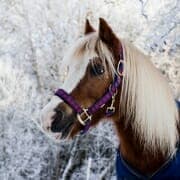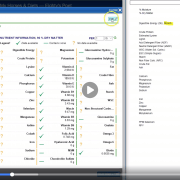Iron for Horses: Could Forage Be Enough?
Comparison of equine dietary iron requirements to iron concentrations of 5,837 hay samples
N. Richards and B.D. Nielsen, 2018
Introduction
Iron is essential for the production of red blood cells. According to the 2007 Horse NRC, Fe requirements are 50 ppm for growing foals, lactating and pregnant mares, and 40 ppm for all other classes of horses. The 2005 NRC suggested a maximum tolerable Fe concentration of 500 ppm using data from other species. It is claimed that excess dietary Fe is causative of horses becoming insulin resistant.
Athletic horses, and particularly those in Thoroughbred racing, are often supplemented with Fe in an attempt to improve performance. Supplementation is commonly carried out without any formal analysis of the diet to determine if additional iron is required. Forages are typically high in iron and supply a majority of iron in all equine diets.
This study looks at the iron concentration in forages typically fed to equines and whether iron from forage is enough to meet the iron requirement of an athletic horse.
Methods
Nutrient concentrations from hay samples submitted for analysis in 2017 and for which Fe was measured were obtained from Equi-Analytical representing 3,060 grass, 1,193 legume, and 1,584 mixed hay samples.
Iron concentration was measured using inductively-coupled plasma mass spectrometry (ICP). Analysis methodology is available from Dairy One. Statistical analysis was performed using Proc MEANS of SAS.
Results
Iron was highest in Legume and Mixed Mainly Legume Hays and lowest in Grass Hay (Table 1). All hay types had a mean iron concentration more than five times that required by athletic horses and a median iron concentration more than three times.
From all hay samples (n = 5,837), 707 contained Fe at or above the suggested tolerable threshold of 500 ppm, while only 81 contained Fe at less than 50 ppm. Further, only 15 contained Fe at less than 40 ppm.
Discussion
A 500 kg horse in heavy work has an iron requirement of 500 mg/day (NRC 2007; based on a daily feed intake of 2.5% bodyweight and a requirement of 40 ppm). Forage intake is often restricted by Thoroughbred trainers. But even when fed at 1% of bodyweight to a 500 kg horse, these hays will supply an average 1,060 mg to 2,230 mg of iron per day, supplying more than 200% of daily iron requirements in the forage component of the diet alone.
Fortified grain concentrates are fed at an average 2.5 kg/horse per day in Australian Thoroughbred racing stables (Richards 2003). These concentrates have an average iron concentration of 190 ppm (FeedXL.com), adding an additional 475 mg/day of iron to the diet of these horses. Almost 60% of Australian Thoroughbred trainers then add an iron supplement to their horses’ diets (Richards 2003). It is expected similar trends would be found in the USA.
Based on this broad diet analysis, forage is able to meet the daily iron requirement of athletic horses. When iron from fortified feeds and supplements is added, there would be few racehorses receiving less than 300% of their daily iron requirement. It’s not unexpected that many horses would be receiving in excess of 500% of their daily iron requirement
What About Insulin Resistance
Given the dearth of Thoroughbred racehorses that are insulin resistant, despite Fe supplementation in combination with diets that can easily supply amounts beyond requirements, it seems unlikely excess Fe causes insulin resistance. However, it is recognized insulin resistant horses may have elevated serum ferritin.
References
Council NR. Nutrient Requirements of Horses: Sixth Revised Edition. Washington, DC: The National Academies Press, 2007.
Richards N, Hinch G, Rowe J. The effect of current grain feeding practices on hindgut starch fermentation and acidosis in the Australian racing Thoroughbred. Aust Vet J 2006;84:402-407.
FeedXL Nutrition Software, https://feedxl.com/, 2018.
HUGE THANKS to Equi-Analytical for providing the data to write this paper, which was presented as a poster at the recent International Conference on Equine Exercise Physiology (ICEEP).

Want to try FeedXL for your horse’s health?
Get EVEN MORE practical and personalised feeding guidance when you sign up to FEEDXL.
Do you have a question or comment? Do you need help with feeding?
We would love to welcome you to our FeedXL Horse Nutrition Facebook Group. Ask questions and have them answered by PhD and Masters qualified equine nutritionists and spend time with like-minded horse owners. It’s free!
Click here to join the FeedXL Horse Nutrition Facebook Group











